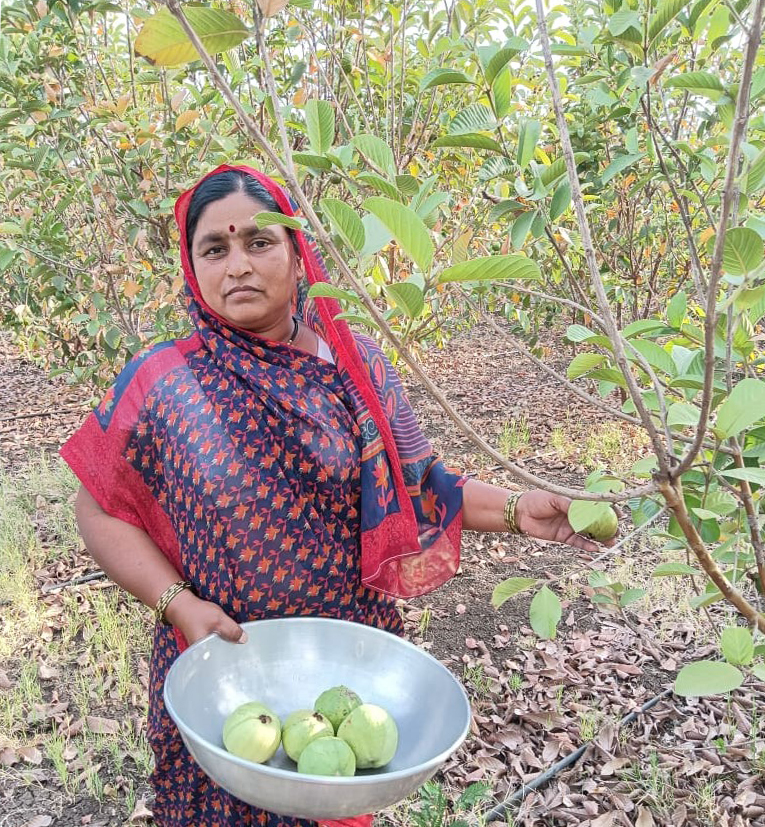Highlights
- Natural farming turns Rs.25,000 income a year to Rs.2 lakh
- Son returns back to village
- Independent farming can bring peace of mind
- Farmers need hand holding at the right time, not only money
- AOL’s initiative has transformed 30 lakh families’ fortunes
While watering her peru (guava) trees, 42-year-old Savitri shares a glimpse of her life journey – “My husband has been unwell for the last three months. We have been on continuous hospital rounds since then. But I have been able to take care of all these expenses. It wasn’t like this until four years ago.”
“I got my kids’ education done. All of them have finished their 12th standard,” Savitri shares. “As a mother I also have taken care of what they eat. It is simple. What I grow is consumed by people buying the produce as well as my family and I make sure it is healthy. I feel so not just for my children but every child anywhere eating these grains, fruits must stay healthy and grow well. That is what every mother desires,” she adds.
“I don’t have a lot of land. I just have 0.75 acres where I was growing jowar and gehu (wheat), making about Rs.25,000 a year. Earlier, along with farming, I used to do tailoring, take loans, and my husband would drive a rickshaw.”
“The Art of Living’s Mahadev Gomare (natural farming and agroforestry expert) helped us,” Savitri says with gratitude. “He is the one who taught me how to make natural inputs at home. He also gave me 350 peru saplings. Now after his training, I am growing dal, pea, and brinjal. I keep changing and switching the vegetables based on water availability, demand, and other factors.”
Savitri continues, “Before I started growing guava on my farm, we were making Rs.25,000. Right now, I have Rs.2 lakhs at home after selling the guavas. This is my 4th year of growing these fruits. It doesn’t even require maintenance. There is not much work after sowing. It takes just one year for it to bear fruit. I made Rs.2 lakhs from the second year itself. This is how I can take my husband to the hospital without worrying much about the expenses.”
“Right now, whatever my situation is, it is only because I changed my farming pattern. I have no dependency on others. I don’t have to ask for loans from anyone. My relatives and neighbors were offering me money but turned them down.”
Since Savitri shifted to agroforestry she has stopped doing additional work. “We are self-sufficient with just 0.75 acres of land. I don’t do any other additional work now. My daughter still does tailoring since all the customers, I believe, are like gods, and I cannot see them return disappointed. My son used to work in the city. He has also returned.”
Marginal Farmers Can Switch to Natural Farming
Even as one farmer dies by suicide every hour in India as per the NCRB data, stories like that of Savitri have become a source of tremendous inspiration and hope for the future of farmers in India, busting the biggest myth that marginal farmers cannot benefit or afford to practice natural farming techniques, or become financially independent from making these changes that involve no cost. She eloquently notes: “Farmers just need support. We don’t need money. Your appreciation of the work we do drives us.”
Savitri has trained her daughter to tend to the farms in her absence — what to water, when to water, how to make the natural inputs at home, since her husband’s illness keeps her away from the fields for days on end.
“My motivation is people like Mahadev Gomare who train us. He doesn’t gain anything from us. I also thought if these people who don’t even know me are doing so much for me, I must also try to make others’ lives better.”
Savitri shares how independent farming brings her calm and stability, “I am 42 years now. I have seen a lot of troubles in my life. My husband is unwell, but I can manage everything. Just spending time on my farm, and seeing fruits grow gives me a lot of stability and confidence. Since I started farming full time, I feel nice. I also have one desi cow now. Drinking the cow’s milk also keeps me healthy. My elder daughter comes and helps me with farming and milking. My life is great now. There are no bank loans,” Savitri likes to repeat, “I run my family with my income.”
The Art of Living has had a significant impact in transforming marginal farmers into sustainable farmers. So far, 30 lakh farmers in India have received this ancient wisdom of reviving and reclaiming their agricultural lands. They were able to replace MNC-sold fertilizers, genetically modified seeds, and pesticides with natural fertilisers. With some training, farmers have been able to reduce their cost by 1/5th while preserving and multiplying rare and precious desi seed varieties through the seed bank.
AOL has trained small and marginal farmers, who own less than 5 acres of land. Typically, farmers spend up to Rs.10,000 per acre on seeds, fertilizers and pesticides. But with the help of natural farming methods, their costs have come down to about Rs.1,000 per acre. They also need less than one-fifths of the water they previously needed for cultivation.










